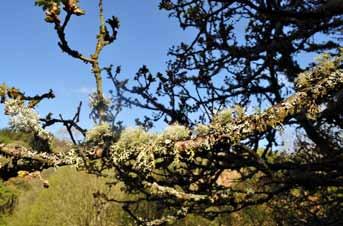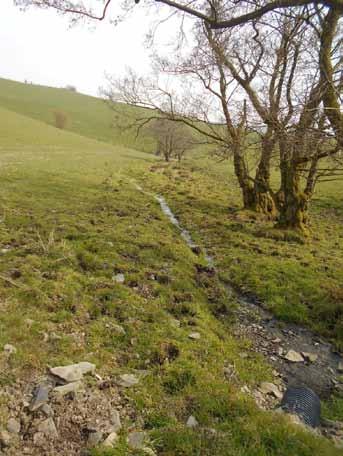
8 minute read
Shropshire
Wishes for improving botanical conservation in Shropshire
Fiona Gomersall
Advertisement
I was asked by John Handley to write an article on three things I would want to change over the next 10 years to improve conservation in Shropshire. This is a big ask as what I wish for is complex and tied up with many other situations which need to change. Writing this article under partial lockdown due to Covid-19 though, has brought many of us hope that our isles and indeed the world have an opportunity to bring about radical change to the way we live in order to tackle species loss and climate chaos. I, like many ecologists dream of a return to a more semi-natural Shropshire – the one I thought I was moving to 25 years ago. I thought I understood that the county had one of the less ‘improved’ landscapes in the UK and was naïve to believe this as, like everywhere else, most of Shropshire’s wetlands had already been drained and the unimproved grasslands ploughed, encouraged by Government grants on offer in the 1970s. The decline and loss of species and habitats kickstarted the countywide habitat survey of Shropshire and the publication of the ‘Ecological Flora of the Shropshire Region’, Sinker et al. Later, John Tucker, working as Conservation Officer at Shropshire Wildlife Trust (SWT) started to notice a loss and decline of local wildlife sites (LWS) and wrote his publication, ‘Losing Ground’, on the disappearance and decline of these prime habitats. Tragically decline of species and habitats has continued. Living near Bury Ditches from 1995 to 2015, I witnessed locally the drastic decline in lapwing numbers. I also noticed a big increase in road traffic accompanied by the eutrophication and trashing of roadside verges, so that a diversity of quite common species was replaced by a monoculture of False Oat-grass Arrhenatherum elatius and Hogweed Heracleum sphondylium. We can’t turn back the clock but we can attempt to restore lost habitats, create new and at least hold on to the best sites still existing like the Long Mynd, the Stiperstones and the 700 or so LWS in Shropshire. My three asks are: 1) Strengthen environmental legislation and regulation to protect semi-natural sites. 2) Ensure a fully-functioning Nature Recovery Network throughout Shropshire linking the protected ‘core’ sites - the SSSIs and NNRs. 3) Improve environmental education at all levels of learning.
1In my years as Conservation Officer at SWT I too saw a decline in LWS. I surveyed many that had lost the criteria that had them adopted in the 1980s. These mostly grassland sites had been ploughed, re-seeded and fertilised or neglected so that fragile species were out-competed by tall grasses and scrub. In 2010 for example, I surveyed the LWSs surrounding Catherton Common and found that 50% had been lost: turned into lawns, ploughed-up, drained, fertilised or overgrazed by horses and sheep. Nearby SSSI were suffering a similar fate. LWS have no statutory protection and so landowners can virtually treat the land as they wish. The loss of sites around Catherton was mostly a result of ignorance or the need to increase horse pasture. The original inhabitants had sold up and newcomers, not knowing that they had inherited something special, had proceeded to destroy it. For many though, the need for horse grazing pasture was stronger than the desire to nurture a species-rich meadow. Distressingly I witnessed further decline following those 2010 surveys. The LWS Botany Bay had already suffered the creation of a horse manège and grassland improvement but new owners then drained the remaining wildflower meadow that had been full of Quaking-grass Briza media, marsh orchids Dactylorhiza spp. and Devil’s-bit Scabious Succisa pratensis. The Environmental Impact Assessment (EIA) Regulations 2011, were brought in to protect vulnerable grasslands like Botany Bay, and Pant y Lidan LWS in the Clun Forest, which was partploughed following the end of the Environmentally Sensitive Area (ESA) farm subsidy. It is a travesty that this is common practice amongst many landowners following the close of a land management scheme. Land that has gradually reverted over the 10 or so years of the scheme to a more natural state, with the return of ‘wild’ grasses and some diversity is then ploughed up to apparently increase productivity. The land is then entered into a new scheme and the owner receives further subsidies for grassland restoration. Although the owner of Pant y Lidan, like all landowners would have been alerted to the relevant EIA paperwork, he like many others who breached the regulations, seemed unaware of the rules when challenged. The EIA is now weakened so that instead of a Natural England ecologist assessing the grassland following a request to plough, drain or fertilise, the owner is required to carry out the assessment themselves. Few that I have met (or their land agents) have the habitat assessment skills necessary for identifying unimproved grassland. The UK agricultural sector is responsible for 88% of ammonia emissions which not only seriously impact on human health but have a destructive impact on semi-natural habitats. Intensively reared cattle, pigs and poultry are responsible for most of these ammonia emissions. The number of intensive poultry units (IPU) in the three counties of Shropshire, Herefordshire and Powys has increased exponentially in recent years so that on any one day there are now around 47 million birds. Large units require permits and have stringent regulations around ammonia emissions but any unit with under 40,000 birds is not regulated and there are plenty of these. In the Shropshire Hills AONB alone there are around 40 IPU, with many more throughout the county. Ammonia has a substantial impact at a local level, so that emissions at ground level lead to rapid deposition with acute effects on small, isolated nature reserves like Ruewood SSSI near Wem. APIS is a website where atmospheric

Lichens are especially sensitive to atmospheric ammonia
ammonia can be measured for all SSSIs and SACs in the UK. In Shropshire, the critical threshold for vegetation damage by ammonia is exceeded on all SSSIs. Heathland SSSIs and those with sensitive lichens and bryophytes like Rhos Fiddle in the Clun Forest are more vulnerable. Lichens are sensitive to 0.1ug/m-3 NH3 and the levels of ammonia can be 100 times this around IPU, leading to direct deaths of sensitive lichens and bryophytes. In vascular plants ammonia enters leaf stomata and if uptake exceeds detoxification, ammonia accumulates interfering with cellular processes and poisoning the plant. Heather Calluna vulgaris in this case will suffer desiccation in winter, drought stress in
summer and is more susceptible to attack by pests and pathogens like Heather Beetle. In addition, excess ammonia increases nitrate concentration (through the nitrogen cycle) in soils which favours more competitive species like grasses so that on moorlands, mosses, lichens and ericoids are replaced by Purple Moor-grass Molinia caerulea, Rosebay Willowherb Chamerion angustifolium and Common Sorrel Rumex acetosa. Monitoring Catherton Common SSSI, I measured a significant increase in Molinia over the last few years. In summary, there is an urgent need for statutory protection of LWS, large penalties for destruction of semi-natural habitats and a moratorium on planning permission for further IPUs accompanied by strict regulations for ammonia emissions from all farming practices.
2The forthcoming Environment Bill lays down the foundation for Nature Recovery Networks (NRN) throughout England and various organisations have been making plans for how this will work. The Environment Bill is not yet through, nor the detail but if there is adequate funding for NRN development, our declining species and habitats could be on a road to recovery. An NRN is a resilient and coherent ecological network which counteracts habitat loss, decline in its quality and fragmentation. In Shropshire, SWT and the Shropshire Hills AONB, along with partner organisations are amassing baseline data and writing plans. The idea of NRNs follows the Lawton Principle (Lawton 2010), which states that isolated SSSI and nature reserves, the core sites have to be made bigger and better and join up with other nature-rich sites. Complexity and dynamism with mosaics of rich habitat supporting diverse food webs will offer the best protection against factors like climate chaos. A fully effective NRN requires core sites to be at least 5,000 to 12,000 hectares in size. The National Trust’s Stepping Stones main project objective to link the Stiperstones NNR with the Long Mynd SSSI is based on the Lawton Principle. The Mynd is around 5400 ha in area and the Stiperstones 588 ha. It would be unfeasible to ‘naturalise’ all farmland between these two core sites, but using LWS as stepping stones, the restoration of semi-natural grasslands and wetlands around and between these could form a network to both connect and expand the two core sites. If recovery is to work, 20% of the network will have to be semi-natural and evidence suggests that improving the permeability of such a ‘matrix’ is more important than providing physical corridors for wildlife dispersal. In addition, the core sites will need to be managed to maximise the survival of as many key species as possible The plan for funding NRNs will be achieved mostly through the New Environmental Land Management Scheme (NELMS) where farmers are paid on a ‘Public Money for Public Goods’ basis. The public goods or ‘natural capital’ are the clean air, unpolluted water, healthy soils and the land which is most effective at absorbing carbon, alleviating flooding and supporting healthy populations of our native flora and fauna.
3My last plea for change is in education. If the public does not value nature or understand the function of landscapes, they won’t be prepared to pay for the necessary restoration and services that nature provides. Most readers will agree that there is an urgency to provide an education in natural history and conservation at all levels of education. If we understand how the natural environment functions to support all life on earth and we cherish the animals, plants and

Restoration of riparian habitat is needed to strengthen ecological networks








